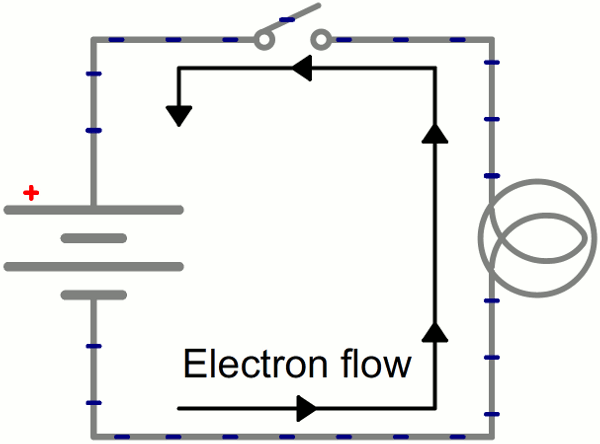What is Electricity?
Electricity in Action!
After studying particle physics, field theory, and potential energy, we now know enough to make electricity flow. Let's make a circuit!
First we will review the ingredients we need to make electricity:
- The definition of electricity is the flow of charge. Usually our charges will be carried by free-flowing electrons.
- Negatively-charged electrons are loosely held to atoms of conductive materials. With a little push we can free electrons from atoms and get them to flow in a generally uniform direction.
- A closed circuit of conductive material provides a path for electrons to continuously flow.
- The charges are propelled by an electric field. We need a source of electric potential (voltage), which pushes electrons from a point of low potential energy to higher potential energy.
A Short Circuit
Batteries are common energy sources which convert chemical energy to electrical energy. They have two terminals, which connect to the rest of the circuit. On one terminal there are an excess of negative charges, while all of the positive charges coalesce on the other. This is an electric potential difference just waiting to act!
If we connected our wire full of conductive copper atoms to the battery, that electric field will influence the negatively-charged free electrons in the copper atoms. Simultaneously pushed by the negative terminal and pulled by the positive terminal, the electrons in the copper will move from atom to atom creating the flow of charge we know as electricity.
After a second of the current flow, the electrons have actually moved very little--fractions of a centimeter. However, the energy produced by the current flow is huge, especially since there's nothing in this circuit to slow down the flow or consume the energy. Connecting a pure conductor directly across an energy source is a bad idea. Energy moves very quickly through the system and is transformed into heat in the wire, which may quickly turn into melting wire or fire.
Illuminating a Light Bulb
Instead of wasting all that energy, not to mention destroying the battery and wire, let's build a circuit that does something useful! Generally an electric circuit will transfer electric energy into some other form--light, heat, motion, etc. If we connect a light bulb to the battery with wires in between, we have a simple, functional circuit.
While the electrons move at a snails pace, the electric field affects the entire circuit almost instantly (we're talking speed of light fast). Electrons throughout the circuit, whether at the lowest potential, highest potential, or right next to the light bulb, are influenced by the electric field. When the switch closes and the electrons are subjected to the electric field, all electrons in the circuit start flowing at seemingly the same time. Those charges nearest the light bulb will take one step through the circuit and start transforming energy from electrical to light (or heat).


